In today's world, competition between restaurants and cafes is growing by the day. While attracting new customers becomes increasingly expensive, retaining existing ones requires a special approach. Loyalty programs not only help attract new customers but also play a critical role in retaining current ones, becoming an inseparable part of a successful business.
In this article, we will examine the story of a customer who has been using the Fenlora loyalty program for three years. We will analyze key performance indicators in detail and learn how the program has impacted their business.
Introduction to Fenlora Loyalty Service
Fenlora was created to improve customer engagement and increase loyalty. The service offers a variety of features such as electronic loyalty card creation, hyper-personalized offers, bonus programs, and customer data analytics.
Fenlora uses AI for push notifications and product recommendations.
Fenlora uses AI for push notifications and product recommendations.
Challenges Faced by Cafes
As a cafe owner or marketer, you have likely encountered the following challenges:
These issues can seriously hinder the growth of your business. This is where Fenlora steps in.
- High costs of attracting new customers
- Low customer retention rate
- Difficulty in measuring the effectiveness of marketing efforts
- Lack of personalized offers for customers
These issues can seriously hinder the growth of your business. This is where Fenlora steps in.
Client 1 – Cafe with 26 Locations
Business Overview: All cafes are located in the city's most densely populated areas. Before using Fenlora, the cafe chain had 17 locations. Within three years, the number of branches increased to 26.
Starting with Fenlora Loyalty Service: July 2021
Primary Goal: Replace the traditional plastic card loyalty program with a modern electronic loyalty system, digitize the customer database, and increase revenue through customer loyalty and retention.
Starting with Fenlora Loyalty Service: July 2021
Primary Goal: Replace the traditional plastic card loyalty program with a modern electronic loyalty system, digitize the customer database, and increase revenue through customer loyalty and retention.
Loyalty Program Structure:
Over three years, various campaigns and automated scenarios were launched. Let’s look at some examples.
- Bonus system for each purchase: 2% cashback
- Personalized offers for loyalty program participants
- Special campaigns for holidays and birthdays
- Automatic notifications and bonus allocation
- Automated scenarios
Over three years, various campaigns and automated scenarios were launched. Let’s look at some examples.

Examples of Loyalty Program in Action
Example of a Personalized Offer:
The service stores the customer's shopping history in its database and identifies their favorite products
Then, a customer segment is created, such as "lactose-free cappuccino lover."
The service sends a mobile push notification:
The service stores the customer's shopping history in its database and identifies their favorite products
Then, a customer segment is created, such as "lactose-free cappuccino lover."
The service sends a mobile push notification:
“Buy a lactose-free cappuccino and get a free donut! This offer is valid from 10:00 AM to 12:00 PM on XL coffee purchases.”
Such campaigns have a higher conversion rate because they consider the customer's preferences. This serves three purposes:
Example of Customer Churn Control:
The service tracks the date of the last purchase and allocates bonuses accordingly. For example, if a customer hasn’t made a purchase in 30 days, the system allocates expiring bonuses to encourage a new purchase, helping to control customer churn.
- Creating a new habit (e.g., buying a donut with coffee), which increases the average order value.
- Encouraging larger coffee purchases, which boosts revenue.
- Promoting purchases during off-peak hours, which helps balance cafe traffic.
Example of Customer Churn Control:
The service tracks the date of the last purchase and allocates bonuses accordingly. For example, if a customer hasn’t made a purchase in 30 days, the system allocates expiring bonuses to encourage a new purchase, helping to control customer churn.
Key Metrics Before and After Implementing Fenlora
Before using Fenlora, the lack of digitized data made it impossible to precisely determine the customer retention rate (CRR). Therefore, we are comparing the metrics from the second and third years of using the service.
Average CRR:
Average Order Value:
Revenue:
Number of Active Customers:
- 2023: 62%
- 2024: 69%
Average Order Value:
- 2023: 93.67 TRY ≈ $3.47 USD
- 2024: 105.85 TRY ≈ $3.92 USD
Revenue:
- 2023: 62,566,951 TRY ≈ $2,314,981 USD
- 2024: 78,881,173 TRY ≈ $2,923,807 USD
Number of Active Customers:
- 2023: 32,311
- 2024: 34,649 (7% increase)
How Much Did Fenlora’s Loyalty Service Generate?
Input Data:
- Annual subscription fee for the service: 124,700 TRY ≈ $4,611 USD
- Bonus expenses: 1,577,172 TRY ≈ $58,474 USD
- Total number of loyalty program users: 53,560
- Active users (those who made at least one purchase): 34,649
Calculations:
- 64% of all users are active.
- Revenue from active users: 59,876,727 TRY ≈ $2,220,444 USD
- Revenue per active user: 1,728 TRY ≈ $64 USD
- Annual growth in active users: 7% (2,338 users)
- Revenue increase from active users: 4,046,341 TRY ≈ $150,717 USD
- Revenue with bonus expenses included: 2,171,346 TRY ≈ $80,454 USD
- Net revenue after subscription fee: 2,023,146 TRY ≈ $75,000 USD
Result: Client 1 generated an additional $75,000 in revenue in just one year using Fenlora.
Conclusion
The Fenlora loyalty program significantly boosted customer loyalty and increased business revenue. Through personalized offers and churn control, the company not only retained existing customers but also attracted new ones, leading to higher revenue and an increased average order value.
If you are looking to solve your customer loyalty challenges and boost your revenue, the Fenlora loyalty program is exactly what you need. Use our solutions to make your business successful and profitable!
